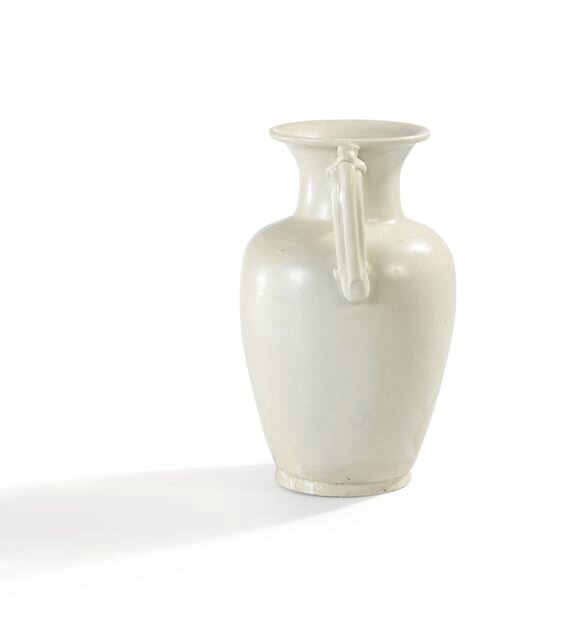Rare aiguière en grès de style Xing, Fin de la dynastie Tang-Cinq Dynasties
Lot 70. Rare aiguière en grès de style Xing, Fin de la dynastie Tang-Cinq Dynasties; 19,9 cm, 7 7/8 in. Estimate 40,000 — 60,000 €. Photo: Sotheby's.
A fine and rare Xing-type stoneware ewer, Late Tang-Five Dynasties
la panse ovoïde allongée surmontée d'un col en trompette, l'anse arrondie en forme de trois tiges nouées flanquée à l'opposé d'un petit bec verseur fuselé, entièrement couverte d'une belle glaçure blanche translucide tirant légèrement vers le céladon et s'arrêtant au-dessus du pied.
Provenance: Acquired in London, March 1996.
Note: The most distinguishing features of Xing wares are the pure white body and their glossy, translucent glaze which has a tendency to run down the surface in thick glassy drops. The body can range in colour from pure white to creamy-white and can be translucent and resonant. The glaze tends to be thin and may sometimes have an attractive bluish tinge. Surfaces as bright, glossy and smooth as those of the best Tang white wares were known only from precious metals and stones. The Tang connoisseur Lu Yu (739-804/5) likened the qualities of Xing wares to those of silver and snow. During the late Tang, Xing white wares developed and represented the finest ware of the north.
White-glazed ewers of this type such as the present piece have variously been attributed to the Xing and Ding kilns of Hebei province made during the late Tang and Five dynasties. Both wares were extremely popular and dominated the market until the Five Dynasties period when Ding wares replaced Xing wares as the most prominent white ware. As technology advanced during the Song dynasty, wood burning kilns were replaced with coal burning kilns which allowed for a clear glaze to display the full whiteness of the ware. It was during this time that the fame of Xing wares spread abroad and large quantities were exported throughout East Asia, the Middle East, South-East Asia, and North Africa.
Compare a similar ewer attributed to the Xing kilns, formerly in the Kempe Collection, illustrated in Bo Gyllensvärd, Chinese Ceramics in the Carl Kempe Collection, Stockholm, 1964, pl. 286, and sold in our London rooms, 14th May 2008, lot 205; compare also a Xing type ewer of this shape and size, sold Sotheby's New York, 13th September 2016, lot 103.
A white stoneware ewer, Tang dynasty; 21.6cm., 8 1/2 in. Sold for 66,500 GBP at Sotheby's London, 14th May 2008, lot 205. Photo: Sotheby's.
Cf. my post: A white stoneware ewer, Tang dynasty (618-907)
A white 'Xing'-type stoneware ewer, Five dynasties, 10th century. Height 8 in., 20.5 cm. Sold for 50,000 GBP at Sotheby's New York, 13th September 2016, lot 103. Photo: Sotheby's.
Cf. my post: A white 'Xing'-type stoneware ewer, Five dynasties, 10th century
Other ewers of closely related form and glaze include an example in the Royal Ontario Museum, illustrated in Yutaka Mino, Pre-Sung Dynasty Chinese Stonewares of the Royal Ontatio Museum, Toronto, 1974, pl. 66; another ewer was included in the exhibition Decorated Porcelains of Dingzhou. White Ding wares from the collection of the National Palace Museum, Taipei, 2014, cat. no. I-8; a third example is published in Illustrated Catalogues of Tokyo National Museum. Chinese Ceramics, vol. 1, Tokyo, 1988, pl. 315.
Sotheby's. Arts d'Asie, Paris, 12 Dec 2017, 10:30 AM

/https%3A%2F%2Fprofilepics.canalblog.com%2Fprofilepics%2F1%2F0%2F100183.jpg)
/https%3A%2F%2Fstorage.canalblog.com%2F03%2F02%2F119589%2F96711876_o.jpg)
/https%3A%2F%2Fstorage.canalblog.com%2F11%2F31%2F119589%2F94773502_o.jpg)
/https%3A%2F%2Fstorage.canalblog.com%2F20%2F83%2F119589%2F94772815_o.jpg)
/https%3A%2F%2Fstorage.canalblog.com%2F26%2F72%2F119589%2F75604929_o.jpg)
/https%3A%2F%2Fstorage.canalblog.com%2F59%2F60%2F119589%2F26458628_o.jpg)








/http%3A%2F%2Fstorage.canalblog.com%2F97%2F49%2F119589%2F129856334_o.jpg)
/http%3A%2F%2Fstorage.canalblog.com%2F25%2F08%2F119589%2F129521423_o.jpg)
/http%3A%2F%2Fstorage.canalblog.com%2F43%2F43%2F119589%2F129237428_o.jpg)
/http%3A%2F%2Fstorage.canalblog.com%2F73%2F38%2F119589%2F128525398_o.jpg)